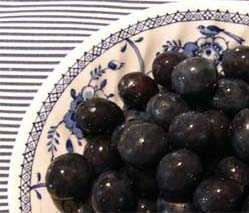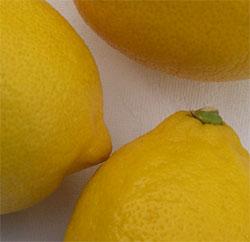Damson Cheese Recipe: for savoury and sweet dishes. How to freeze damsons/plums.
Posted by Fiona Nevile in Jam Jelly and Preserves | 65 comments
A dish of ripe damsons
At this time of year, we are given a lot of fruit for preserves. Quite often we pop them in the freezer (how to freeze damsons? See tricks and tips below) until we have time to turn it into something delicious. This morning we decided to make damson cheese.
Damson cheese is not cheese as we know it, Jim. It’s sweet, full of flavour and so dense with fruit that it is sliced, just like cheese. It’s tasty and just that bit more unusual than jelly. I do regret the occasion when my mum gave me a jar ten years ago; I didn’t even taste it before it died a furry death in my fridge. Now I know better.
Traditionally, damson cheese is sliced and served with lamb or game. We eat it with cheese and quite often have it as a pud with a dollop of cream. A slice on an individual plate of hors d’oeuvres looks classy.
Damson cheese is well worth adding to your repertoire.
If you are going to make damson cheese, make sure that you have some straight sided glass jars, or earthenware pots to pour it into so that you can easily slide it out for slicing. (Why not plastic? See tips and tricks below).
Recipe for our excellent damson cheese:
Ingredients:
- 2lbs/917gms of damsons
- 1/4pt/150ml of water
- White granulated sugar (1lb to each 1pint of damson puree)
- A squeeze of lemon juice( approximately 1/2 tsp)
Method:
- Wash, pick over and discard bad fruit.
- Put damsons and water in a large heavy bottomed saucepan. Bring gently to simmering point and simmer very gently until all fruit is soft and falling of the stones (this can take at least an hour or more). Keep an eye on it, stirring from time to time.
- When fruit is very soft, remove from the heat and cool before straining and pressing through a medium sieve. Discard the stones.
- Pour fruit into a measuring jug, note the quantity and return to the cleaned pan with the sugar and lemon juice.
- Stir over a gentle heat stir until sugar is dissolved.
- Bring to the boil and continue to boil briskly. Stir constantly, to stop the sugar burning on the base of the saucepan. Don’t skip this bit.
- The damson cheese it ready when the spoon makes a clear track mark on the bottom of the pan. Not a parting of the seas but but a glimpse of the bottom.
- Ladle into warmed, sterilised straight sided jars. (How do I sterilise jars and lids? See tricks and tips below).
- Allow to cool a little, whilst still warm, and cover with sterilised plastic lined screw topped lids or waxed disks and cellophane covers.
- Label when cold and store in a cool, dark, dry area. It should keep for a year.
- Once opened, keep in the fridge and eat within a month or so.
Tips and tricks:
How to freeze damsons (also how to freeze plums, blackberries, greengages, wild damsons and sloes):
- Pick over fruit and discard any bad fruit
- Wash fruit and dry in a large clean tea cloth
- Put fruit into labelled bags and freeze
Why can’t I use plastic (i.e. ice cream cartons, to store damson cheese in my fridge?
- A friend, who is a great chef, made a batch of damson cheese purely for personal consumption. The damson cheese was poured into a large clean, sterilised ice cream carton. Every now and then, a sizeable nugget of damson cheese was savoured. After a few months (once opened damson cheese keeps for ages in the fridge) the plastic tainted the damson cheese and the private cache had to be thrown out. Glass and earthenware are fine for damson cheese. After opening, store in the fridge.
How do I sterilise jars and lids?
- Sterilising the jars and lids:
We collect jars all year round for our jelly, chutney and jam making sessions. I try to soak off labels and store the clean jars and metal plastic coated screw-top lids in an accessible place. The sterilising method that we used is simple. Just before making the ‘cheese’, I quickly wash and rinse the jars and place them upside down in a cold oven. Set the temperature to 160c/140c for fan assisted. When the oven has reached the right temperature I turn off the heat. The jars will stay warm for quite a while. I only use plastic lined lids for preserves as the all-metal lids can go rusty. I boil these for five minutes in water to sterilise them. If I use Le Parfait jars, I do the same with the rubber rings.
Leave a reply






Hi, our neighbours gave us some damsons over the weekend, and I made a batch of Damson cheese today. I followed your recipe exactly, and it has turned out very well.
Your tip about when to stop heating was spot on.
Very many thanks,
White.
Hello Nemone
Well done you starting with this recipe as it can be quite tricky.
Welcome to the world of jam making!
I just got given some damsons and have made this today (my first foray into any kind of jam making). If the lickings of the pan are anything to by – it is FAB! Can’t wait to try it properly 🙂
Thank you
Hello Duncan
I’ve had two forays into the garden and picked enough nasturtium seeds for half a jar but I do have two other areas to harvest. Fingers crossed.
Hi Hilary
The first time that I attempted damson cheese it all went horribly wrong and I made a vast boiled sweet.
Reading through the recipe again, I think that you have been misled by ‘draining through a sieve’. It should read draining and pressing through a sieve. Many apologies. The mixture should be quite thick before you add the sugar and only take about twenty minutes max to set.
Hello Anne N
Not having tried your method I can’t really advise. However if I was going to experiment I’d use a baking tray, pour the mixture in no more than 2 centimetres in depth and bake in a really low oven overnight.
Hi Sally
Love the additions 🙂
Glad that it worked well for you.
I’ve just made this with the addition of a stick of cinnamon and half a dozen cloves. It’s so good I’ve rethought my plan of turning the rest of the damsons into jam. Thanks for the recipe.
Is there any reason why I can’t make the cheese in a loaf tin and seal it over with tin foil if I want to eat it sooner rather than later?
Oh Dear! I have just spent some considerable time making the damson cheese recipe but it’s all gone horribly wrong. All was going well until it started to smell different i.e.burnt. Trust me, I didn’t even get a glimpse of the bottom of the pan and was so careful with the instructions. Any suggestions as to where I may have gone wrong?
Hi Fn
Let me know what you think. I usually add just a glug of brandy or rum at the last moment, give it a stir and put it in the jars. It is great eaten as a small pudding with a dollop of brandy butter.
How did you get on with the Nastursium seeds, did you find some? I have managed to get two more jars on the go which is very exciting.
Hi Duncan
Can’t wait to try this after Christmas.
Hello Alice
The damson cheese can be eaten immediately. Most of our chutney recipes can be eaten immediately too!
Hi, this looks like a great recipe!
Just wondering, do you need to leave the damson cheese for any amount of time between making and eating (as with chutney) or is it okay to use fairly immediately (like with bramble jelly, for example).
Thanks,
Alice